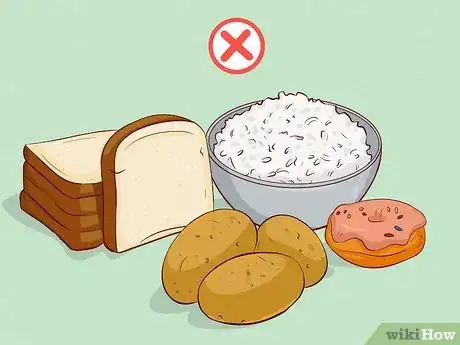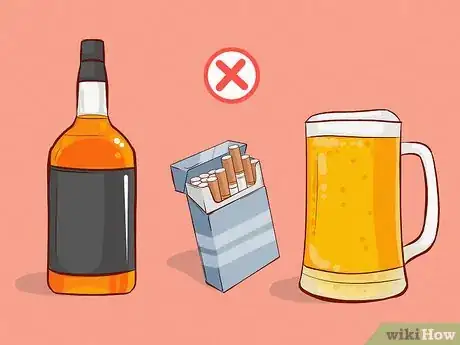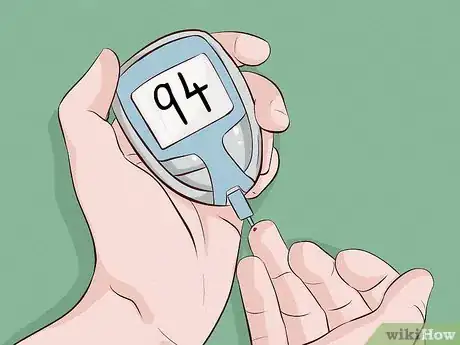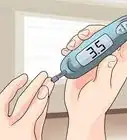This article was co-authored by Damaris Vega, MD and by wikiHow staff writer, Madeleine Criglow. Dr. Damaris Vega is a board certified Endocrinologist. She graduated Magna Cum Laude from the Pontifical Catholic University of Puerto Rico with a BS in General Science and subsequently earned an MD from the Ponce School of Medicine, Ponce, PR. During medical school, Dr. Vega served as president of the Alpha Omega Alpha Medical Honor Society and was selected as her school's representative for the American Association of Medical Colleges. She then completed a residency in Internal Medicine and a fellowship in Endocrinology, Diabetes, Mineral, and Metabolism at The University of Texas Southwestern Medical School. Dr. Vega has been recognized for excellent patient care multiple times by the National Committee for Quality Assurance and received the Patients' Choice Award in 2008, 2009, and 2015. She is a fellow of the American College of Clinical Endocrinologists and is an active member of the American Association of Clinical Endocrinologists, the American Diabetes Association, and the Endocrine Society. Dr. Vega is also the founder and CEO of Houston Endocrinology Center as well as a principal investigator for multiple clinical trials at Juno Research, LLC.
There are 16 references cited in this article, which can be found at the bottom of the page.
This article has been viewed 69,286 times.
High blood sugar, or hyperglycemia, is most commonly caused by diabetes, which should be managed and treated carefully under a doctor's supervision. There are, however, a lot of simple actions you can take to reduce your blood sugar back to a healthy level! This article gives a rundown of the many changes you can make to lower your blood sugar levels, including modifying your diet and exercise routine, monitoring your blood sugar levels, and even reducing stress in your life. If you want to lower your blood sugar levels, read through this article to find tips on how to do so safely and effectively.[1]
Steps
References
- ↑ Damaris Vega, MD. Board Certified Endocrinologist. Expert Interview. 11 November 2020.
- ↑ https://www.pcrm.org/good-nutrition/nutrition-information/the-carbohydrate-advantage
- ↑ https://www.hsph.harvard.edu/nutritionsource/carbohydrates/carbohydrates-and-blood-sugar/
- ↑ http://www.diabetes.org/food-and-fitness/food/what-can-i-eat/making-healthy-food-choices/fruits.html
- ↑ https://www.hsph.harvard.edu/nutritionsource/carbohydrates/carbohydrates-and-blood-sugar/
- ↑ https://www.hsph.harvard.edu/nutritionsource/carbohydrates/carbohydrates-and-blood-sugar/
- ↑ https://www.helpguide.org/articles/healthy-eating/choosing-healthy-carbs.htm
- ↑ https://www.hsph.harvard.edu/nutritionsource/carbohydrates/carbohydrates-and-blood-sugar/
- ↑ https://www.hsph.harvard.edu/nutritionsource/carbohydrates/carbohydrates-and-blood-sugar/
- ↑ https://www.hsph.harvard.edu/nutritionsource/carbohydrates/carbohydrates-and-blood-sugar/
- ↑ https://www.hsph.harvard.edu/nutritionsource/carbohydrates/carbohydrates-and-blood-sugar/
- ↑ https://www.mayoclinic.org/diseases-conditions/type-2-diabetes/expert-answers/diabetes/faq-20058540
- ↑ http://www.mayoclinic.org/diseases-conditions/type-2-diabetes/expert-answers/diabetes/faq-20058540
- ↑ https://health.clevelandclinic.org/how-to-reduce-cortisol-and-turn-down-the-dial-on-stress/
- ↑ https://my.clevelandclinic.org/health/articles/8133-stress-10-ways-to-ease-stress
- ↑ Damaris Vega, MD. Board Certified Endocrinologist. Expert Interview. 11 November 2020.
- ↑ http://www.mayoclinic.org/diseases-conditions/diabetes/in-depth/diabetes-and-exercise/art-20045697
- ↑ http://www.nlm.nih.gov/medlineplus/ency/patientinstructions/000083.htm
- ↑ http://www.diabetes.org/food-and-fitness/fitness/exercise-and-type-1-diabetes.html
- ↑ http://www.mayoclinic.org/diseases-conditions/diabetes/in-depth/diabetes-and-exercise/art-20045697
- ↑ https://www.mayoclinic.org/diseases-conditions/diabetes/in-depth/diabetes-and-exercise/art-20045697
- ↑ https://www.mayoclinic.org/diseases-conditions/diabetes/in-depth/diabetes-and-exercise/art-20045697
- ↑ http://www.diabetes.org/food-and-fitness/fitness/exercise-and-type-1-diabetes.html
- ↑ https://www.mayoclinic.org/diseases-conditions/diabetes/in-depth/diabetes-and-exercise/art-20045697
- ↑ http://www.mayoclinic.org/diseases-conditions/type-2-diabetes/basics/treatment/con-20031902
- ↑ http://www.mayoclinic.org/diseases-conditions/type-2-diabetes/basics/treatment/con-20031902
- ↑ http://www.mayoclinic.org/diseases-conditions/type-2-diabetes/basics/treatment/con-20031902
- ↑ http://www.mayoclinic.org/diseases-conditions/type-2-diabetes/basics/treatment/con-20031902
- ↑ http://www.mayoclinic.org/diseases-conditions/type-2-diabetes/basics/treatment/con-20031902
- ↑ Damaris Vega, MD. Board Certified Endocrinologist. Expert Interview. 11 November 2020.
- ↑ https://www.mayoclinic.org/diseases-conditions/diabetes/in-depth/diabetes-diet/art-20044295
- ↑ https://www.uofmhealth.org/health-library/hw133134
- ↑ http://www.mayoclinic.org/diseases-conditions/type-2-diabetes/basics/treatment/con-20031902


































































Medical Disclaimer
The content of this article is not intended to be a substitute for professional medical advice, examination, diagnosis, or treatment. You should always contact your doctor or other qualified healthcare professional before starting, changing, or stopping any kind of health treatment.
Read More...